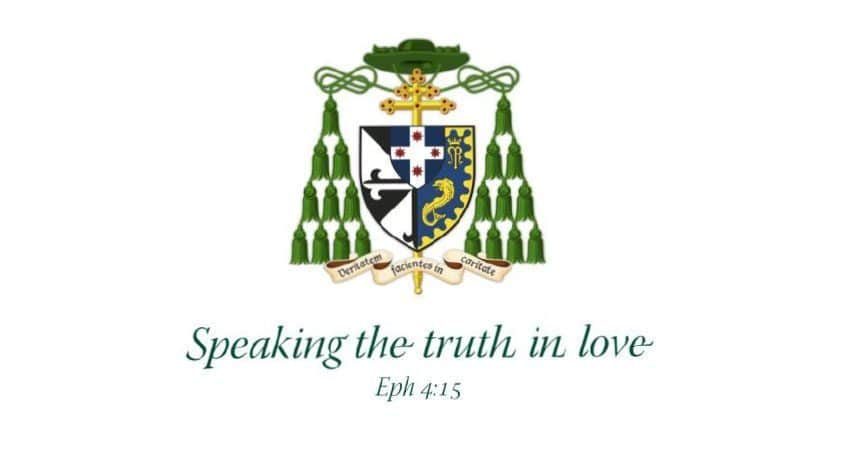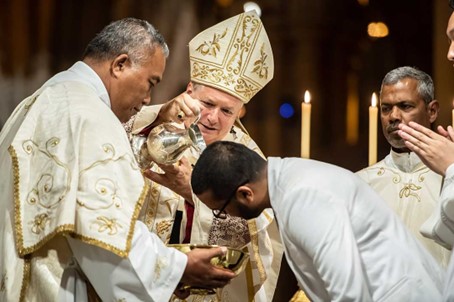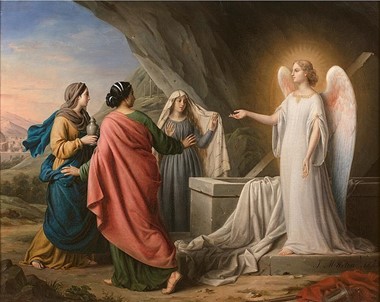III. DEATH OVERCOME: HOMILY FOR THE EASTER VIGIL IN THE HOLY NIGHT

ST MARY’S BASILICA, SYDNEY, 8 APRIL 2023
Health officials called her the Mystery Girl, following her rescue from the devastating earthquake in southern Türkiye and neighbouring Syria earlier this year. Three-and-a-half-month-old Vetin Begdas had been buried for five days beneath the rubble of her family home in Hatay province. Amongst the more than 50,000 dead were all Vetin’s siblings and parents—or so it was thought. Just last Monday, it was discovered that Vetin’s mother had survived the earthquake but been taken to a different hospital. Following DNA confirmation, Mum and Bub were reunited after 54 days apart.[1]
We naturally reach for words like ‘miracle’ and ‘mystery’ when it comes to such remarkable tales of survival. Even more evocatively, we say things like “snatched from the jaws of death” or “escaping death’s clutches” when by ordinary logic these people shouldn’t be alive. Stories of overcoming death against all odds fill us with hope, and provide welcome relief from our background fear of death and its partner grief.
Jesus taught us much about how to think about life, death and afterlife. Whilst He acknowledged the loss that is death and experienced it for Himself; whilst He shared in our tears and grief at the death of others; still He insisted that our fear should be of spiritual death more than bodily (Mt 10:28; cf. 1Jn 2:17). He told us it’s better to store heavenly riches than earthly ones, wealth that lasts into eternity (Mt 6:19-21). He said we shouldn’t obsess over the small stuff, like what we are to eat or wear, reminding us of God’s providential care even for the animals and plants (Mt 6:25-34; Lk 12:22-32). “Can any of you, by worrying, add a single hour to your span of life?” We must be prepared to give up worldly concerns and if needs be life itself.[2] But the goal of this is more life and better, not less. I came, He said, that you might have life, life in abundance; for you I am the Resurrection and the Life; believe in Me and have eternal life.[3]
“Are we not perhaps all afraid… that if we let Christ enter fully into our lives, if we open ourselves totally to him… that He might take something away from us?” the late Pope Benedict asked at his inauguration. “No!” he declared, “If we let Christ into our lives, we lose nothing, nothing, absolutely nothing of what makes life free, beautiful and great. Only in this friendship are the doors of life opened wide… the great potential of human existence truly revealed… beauty and liberation experienced… Open wide the doors to Christ—and you will find true life!”[4]
Yet all Jesus’ promises and our fine words were over-shadowed by the cross of Good Friday. The faith of His friends evaporated and they fled the scene. Our fear and grief are reasonable if even the Author of Life can suffer death. “He saved others,” they said in their hearts, echoing the jeering mob, “can’t he save himself?” (cf. Mt 27:42)
Yet, on that first Easter Morning, Jesus’ many lessons on life, death and afterlife came to their fulfillment. The empty tomb (Mt 28:1-10) confirms that He is much more than a guru or counsellor, pop star or influencer. He is, in the words of the Exultet, our mighty and eternal king, our glorious Redeemer, our Morning Star. He “broke the prison-bars of death and rose victorious from the underworld”. He “wed the things of heaven to those of earth, the divine to the human”. His rising was the beginning of the end “for gloom and darkness”. “Christ, as we know, having been raised from the dead, will never die again. Death has no more power over him anymore.” (Rom 6:3-11)
Which is all very well for Jesus, but what does it mean for us? God, our readings tell us, would not allow Abraham to sacrifice his son (Gen 22:1-18), but with a love beyond all telling (Isa 54:5-14), gave up His own Son “to ransom a slave”, that is us (Exultet; Mt 20:28; Jn 3:16). His resurrection is for our sake: it is our door to the afterlife. The empty tomb deals Death its final death blow. And so, Paul taunts Death “Where, O grave, is your victory? Where, O Death, is your sting?” (1Cor 15:55-58) And each solemn Alleluia tonight ended as if laughing at Death:

Of course, the Holy Thursday fear of death and the Good Friday grief don’t melt away just because we have faith in Christ’s Resurrection. Those with faith still care.[5] But Easter proves that the separation from God and loved ones that began with the Fall is not God’s plan for us; sin and death, separation and abandonment, are not of God. For now evil still surrounds us, but it is merely parasitical, an absence of good, like death is an absence of life. But evil and death are not the end: God is determined to fix them.

Death is not the last word: it’s Alleluia! As Paul tells us tonight, Christ joins us in death so we might join Him in eternal life (Rom 6:3-11). The baptismal Alleluia is Easter’s answer to the perennial questions of the last three days. Shortly, our catechumens Mark (in baptism “Paul Augustine”) Humphrey-Jenner and Zhangli-Xu (in baptism “Jerome”) will pass in baptism through the waters of the Red Sea to freedom from sin (Ex 14:15-15:21; Rom 6:3-11). Their souls will be cleansed and their hearts renewed, and they will receive water and wisdom for thirsty souls (Isa ch. 12; 55:1-11; Bar 3:9-4:4; Ezek 36:16-28; cf. Jn ch. 4). The water that flowed from Christ’s pierced side on the cross (Jn 19:34) was for them. And in their Reception and Confirmation, Hui Yee Siow now Jocelyn “Mary” and Madelyn Judith “Anastasia” Smith, will declare their faith and renew the grace of Baptism with all of us.

Dear brothers and sisters, in the fearful face of death’s shadow, a glorious angel tells the frightened women to “Be not afraid” (Mt 28:5). In the depths of grief at our Saviour’s death, the Risen Lord tells them and us also, to “Be not afraid” (Mt 28:10). “Death is swallowed up in my victory… behold, I make all things new (Isa 25:8; 1Cor ch. 15, esp. vv. 26,54-55; Rev 1:18; Rev 21:5).
Word of Thanks after Holy Communion
Dear friends: my thanks to you all for joining me for this celebration of the Easter Vigil in the Holy Night at St Mary’s Cathedral. It has been a truly beautiful Mass and a fitting culmination of three days of extraordinary liturgies and devotion. I offer my heartfelt thanks to our concelebrants, including Bishop Terry Brady, Dean Don Richardson with the cathedral clergy, Precinct Manager Helen Morassut and staff, Sacristan Chris Backhouse and our servers, Master of Ceremonies Fr Lewi Barakat with the deacons and seminarians, and our year-round volunteer readers, ushers, bell-ringers and ministers. They’ve worked hard all Holy Week, prepared this cathedral church, rehearsed, and then assisted at this Mass and many other ceremonies: I am hugely grateful.
The Good News of Christ’s empty tomb is hope for every fearful and grieving heart, and so must be shouted from our steeples and sung as an Alleluia chorus. For this we thank the Acting Director of Music, Simon Nieminski, Koen van Stade, Acting Assistant Director of Music, our musicians, lay clerks, choristers and staff: they have done splendidly yet again this year. I also thank Paula Flynn, Fr Lewi and our excellent RCIA team for preparing our catechumens and candidates for this night, along with all who have contributed to their journey of faith. To Mark, Shu, Jocelyn and Madelyn, congratulations and welcome to the Church!
Finally, on behalf of the Dean, clergy and staff of the cathedral, and my own behalf, a very Happy Easter to you and all your loved ones. May God bless you abundantly in this holiest of seasons.
[1] https://www.nst.com.my/world/world/2023/04/895716/turkiye-earthquake-survivor-baby-reunited-mother-after-54-days?utm_source=nst&utm_medium=mostpoplatest
[2] Mt 10:37-39; 16:24-25; Mk 8:34-35; Lk 9:23-24; 14:25-33; 17:33; Jn 12:24-26.
[3] Jn 1:4; 3:15-16,36; 4:14; 5:21-29,39-40; 6:27-68; 8:12; 10:10-11,15-17,28; 11:17,25,38; 12:25,50; 14:6; 17:2-3 etc.
[4] Pope Benedict XVI, Homily at Mass for the Imposition of the Pallium and Conferral of the Fisherman’s Ring, St Peter’s Square, 24 April 2005.
[5] See Hayden Ramsay, ‘Death Part IV: Life after death,” New Blackfriars 86(1005), 528-536.

